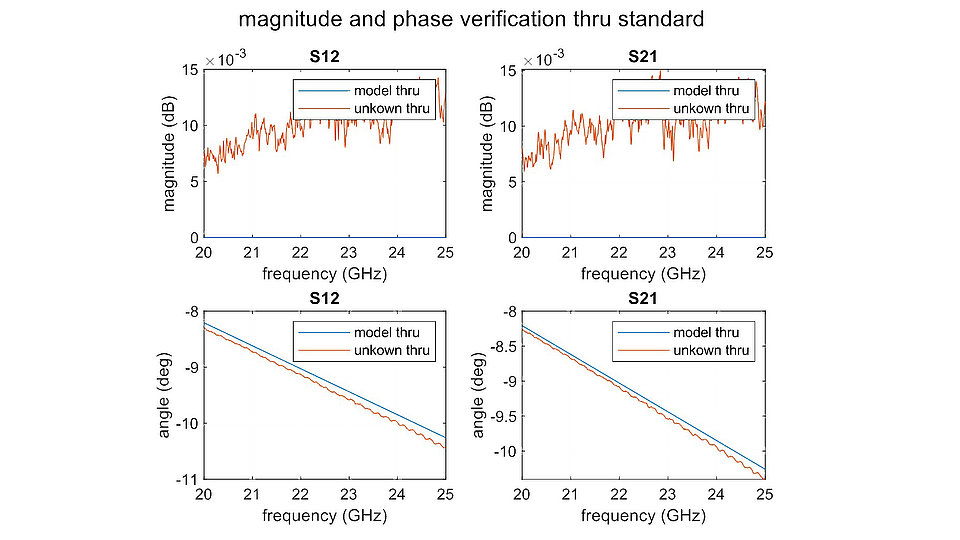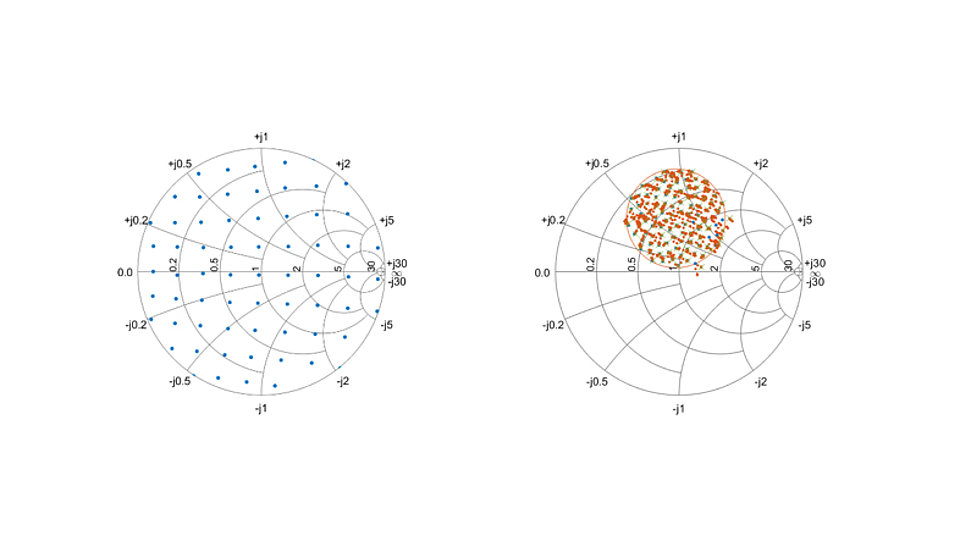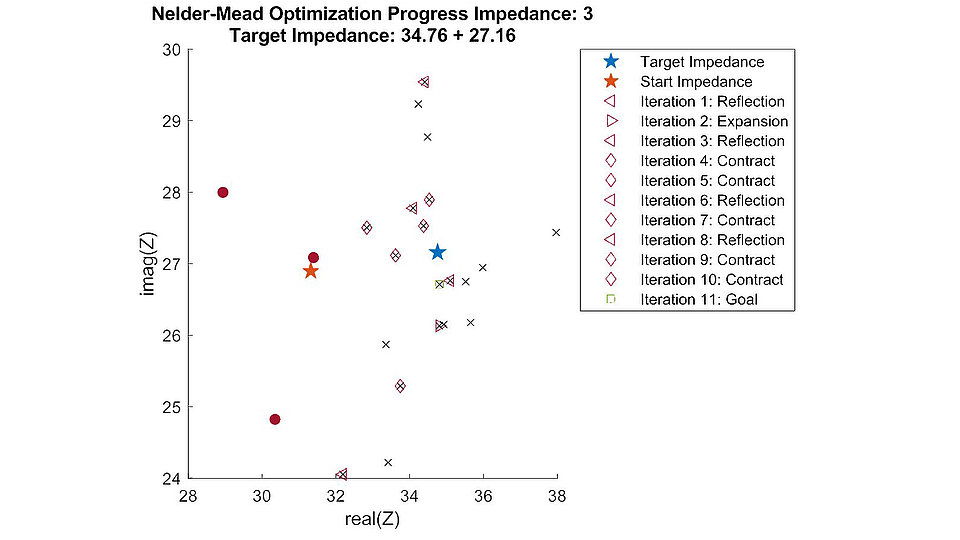mmWave active load-pull for RF power transistor optimization
Fig. 1: Validation of 2-Port calibration accuracy using an 8-term LSNA error model, achieved by comparing error-corrected measurements of a thru line with its theoretical model.
Fig. 2: Generated load impedances across the entire Smith chart (left) and the iterative process of load impedance generation, showcasing all simplex combinations within a defined circle (red) to identify the target impedance (blue). The green crosses represent final values that are within a specified tolerance of the target.
Accurate large-signal measurements of RF power transistors are essential for optimizing MMIC (Monolithic Microwave Integrated Circuit) power amplifiers. A key factor in evaluating the large-signal performance of transistors is impedance matching, where the input and output impedances presented to the transistors are varied to emulate the conditions in an MMIC circuit. Impedance matching can identify maximum power conditions, minimize reflections, and enhance efficiency. A properly matched transistor requires less input power to achieve the desired output, reducing energy waste and heat, which improves device longevity. In power transistors, matching is crucial for improving Power Added Efficiency (PAE), which measures how effective a transistor converts DC power into RF energy.
Active load-pull is an advanced technique used to create impedance matching by injecting coherent waves to establish the desired matching impedances. It allows engineers to dynamically control the impedance presented to the transistor, enabling fine-tuned vector-corrected adjustments to identify the best impedances for optimized performance in, e.g., RF systems like wireless networks and satellite communications.
The innovative 5G-MIMO measurement system at FBH, built around modified vector network analyzers (VNAs), facilitates wideband modulated measurements across multiple ports. This system has recently been documented in several publications [1], [2]. Since its initial presentation, the measurement system has been further enhanced to include on-wafer continuous wave (CW) transistor measurements up to 67 GHz under load-modulated conditions with a first implementation covering the K and Ka-band from 20 to 40 GHz. Implementing mmWave active load-pull to the 5G-MIMO system extends the setup for precise impedance matching, optimizing RF power transistors for maximum performance and efficiency. This is achieved using an external IQ mixer to create phase and amplitude control of a coherent wave injected at the output of the device under test (DUT). However, this advancement requires load- and source-match-independent calibration routines, as an active wave is injected at the output to create the active load. To address this, we implemented the well-known 8-term error model based on an SOLR (short, open, load, reciprocal thru) calibration. The error model utilizes wave measurement data from the PNA-X.
Notably, no wideband modifications are used, as it operates within a narrowband, CW application where only the incident and reflected waves from all receivers are measured by the VNA and subsequently processed with MATLAB. The calibration procedure also corrects the absolute power level at the reference plane using an external power meter, with plans for relative phase calibration to be implemented shortly. This process involves additional steps, increasing the complexity of the overall calibration routine. The calibration accuracy has been verified on-wafer by measurement of a thru line, with results compared to data provided by the calibration-kit manufacturer. The findings demonstrate excellent accuracy, with a phase deviation of less than 0.1 degrees (Fig. 1) across the desired frequency band, likely influenced by manual probing techniques and variations in the contact of the probe tips during calibration.
The integration of the open-loop active load-pull functionality into the 5G-MIMO system provides a more accurate setup with vector-corrected mmWave load-pull compared to other passive load-pull systems. Similar to commercially available systems, the DUT can be assessed across the entire Smith chart using a defined set of load impedances that exceed a reflection coefficient (gamma) greater than 1, depending on the DUT and the available pre-amplifier for the injected output signal. In a certain scenario, one may request a specific set of load impedances within a particular range to thoroughly analyze the DUT's performance. This is accomplished by establishing a starting impedance, a limitation circle, and the desired number of target impedances. These target impedances are generated in a sunflower seed distribution pattern around the initial value, ensuring an evenly spaced distribution within the defined circle (Fig. 2).
For each target impedance, the I and Q values of the external mixer are adjusted iteratively until the generated impedance receives the target values within a specified tolerance. This iterative process allows each measurement to be stored in a history log, which can be leveraged to determine the optimal starting value for subsequent targets. To significantly enhance the efficiency of the iteration process, the Nelder-Mead algorithm has been implemented to identify impedances that minimize error within seconds. This algorithm generates a simplex, which is a geometric shape characterized by three vertices in a two-dimensional space. Various operations, such as reflection, expansion, contraction, and shrinking reshape the simplex, guiding it toward minimum error (Fig. 3). The simplex continuously aligns itself with a local optimum and ultimately compresses around it. This method is not only utilized to identify target load impedances but also to determine the maximum output power or PAE of the DUT. During the simplex generation of varying load impedances, the DUT’s output power at the reference plane is measured continuously until it stabilizes over a specified number of iterations. Additionally, all measurements are recorded, allowing optimal values to be used for subsequent DUT evaluations, such as those conducted on different shots of a wafer, thereby reducing overall measurement time.
This work was partly funded by the German Federal Ministry of Education and Research (BMBF) under the project reference 16FMD01 (Forschungsfabrik Mikroelektronik Deutschland).
Publications
[1] C. Schulze et al., "A VNA-Based Wideband Measurement System for Large-Signal Characterization of Multiport Circuits," in IEEE Transactions on Microwave Theory and Techniques, vol. 72, no. 1, pp. 638-647, Jan. 2024, doi: 10.1109/TMTT.2023.3325105.
[2] M. Mengozzi et al., "Wideband Automated Tuning of Ka-Band Dual Input Doherty MMIC PA using Bayesian optimization," 2023 18th European Microwave Integrated Circuits Conference (EuMIC), Berlin, Germany, 2023, pp. 1-4, doi: 10.23919/EuMIC58042.2023.10288920.


